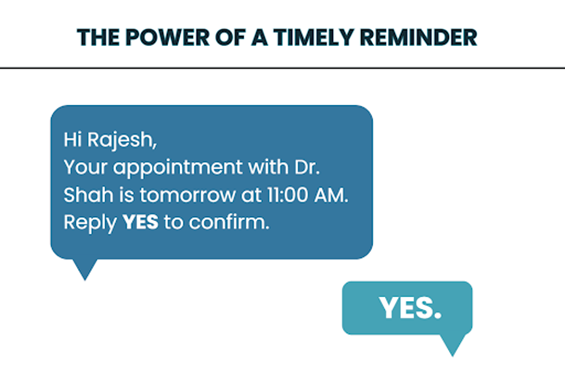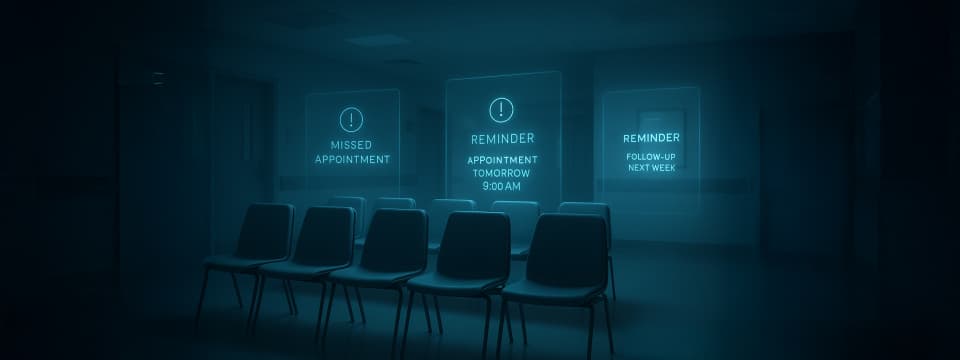For orthopedic surgeons, missed appointments don’t just disrupt the flow — they trigger a chain reaction. A no-show isn’t just lost revenue; it’s a patient missing critical care. It’s a post-op follow-up that never happens. The reasons are often surprisingly simple: forgotten dates, unclear instructions, or anxiety left unaddressed. But the consequences are far more complex, impacting both patient health and clinic performance.
With AI on our side, automation becomes more than just a convenience; it becomes a powerful tool. It’s a lifeline for stronger patient engagement, relieving the burden of manual reminders and follow-ups. With the right reminder and follow-up system in place, orthopedic practices can regain control of their schedules and deliver a more consistent care experience.
It may sound a bit technical, but it’s worth understanding. Let’s explore what’s really behind no-shows and how automated reminders can help keep every appointment and every patient right on track.
The True Cost of No-Shows for Orthopedic Practices
Every missed appointment carries a hidden price tag — and it’s more than just the empty slot on your calendar.
Let’s talk numbers first.
Studies show that no-show rates in outpatient specialty clinics range from 15% to 30%, depending on the location and patient demographics. For high-value appointments, such as surgical consults or post-operative reviews, this translates into thousands of rupees in lost revenue per slot, not to mention wasted preparation time, idle staff, and underutilized clinical resources.
But the deeper cost is clinical:
- A skipped physiotherapy check-in can delay recovery.
- A missed post-op visit could mean unmonitored complications.
- A delayed diagnosis might push back surgery timelines or worsen joint deterioration.
Each missed visit sets off a chain reaction, burdening the care team with rescheduling, coordination, and catch-up care. Over time, it breeds inefficiency, burnout, and fractured trust between the clinic and its patients.
For many orthopedic practices, especially high-volume ones, even a handful of no-shows per week can disrupt planned surgeries, waste operating room (OR) time, and create backlogs that are difficult to recover from. And for patients, a missed appointment may lead to disengagement, delayed recovery, or, worse, abandoning treatment altogether.
Fortunately, technology now offers a simple way to prevent these costly gaps in care, paving the way for a more efficient and patient-centric orthopedic practice.
How Automated Appointment Reminders Can Reduce No-Shows
Today, most orthopedic clinics already rely on digital tools to manage schedules, patient records, and billing. However, many don’t fully leverage the power of automation built into these systems or available through simple integrations.
With the help of practice management software or EHR systems, clinics can now set up automated appointment reminders that go out via SMS, email, or even WhatsApp. These reminders are triggered the moment an appointment is booked and can be customized to send at intervals, such as 48 or 24 hours before the visit.
But it’s not just about sending messages. These tools can also:
- Detect whether a patient hasn’t confirmed and send a gentle nudge
- Offer rescheduling options with one tap if the timing doesn’t work
- Sync with your existing calendar or EHR to keep your team updated
When reminders are automated and intelligently timed, they help reduce forgetfulness, ease patient anxiety, and keep your clinic running smoothly, especially when dealing with multi-stage care, such as post-operative visits or long-term joint recovery.
That said, not all reminders are created equal. Let’s look at how to send them the right way.
Best Practices for Sending SMS, Email, and WhatsApp Reminders
Each communication channel serves a unique purpose in ensuring patients stay informed, feel supported, and follow through with their care plan. Choosing the right one, or combining a few, depends on your patient demographic, the nature of the visit, and your clinic’s workflow.
SMS Reminders
These are ideal for time-sensitive notifications as they are short, direct, and hard to miss. They work best for confirming appointments 24 hours in advance or sending quick reminders about diagnostics, imaging, or follow-ups.
Simple reminders like these can prevent missed appointments.

In the hustle of everyday tasks, a concise reminder can help refocus attention on what matters most and ensure nothing is forgotten.
Also, a pro tip here: Include your clinic’s name, keep it clear, and skip the jargon — sometimes, a straightforward nudge is all it takes.
Email Reminders
These kinds of reminders are more suited for detailed communication. Emails are great for first-time patients or anyone scheduled for a procedure, as they may require pre-visit instructions, location details, or links to necessary forms. A well-designed email template that strikes a balance between professionalism and care can enhance open rates and reduce the likelihood of patients arriving unprepared or late.
WhatsApp Reminders
WhatsApp offers a more conversational, familiar touch, especially in regions where it’s the default communication app. Using the WhatsApp Business API, clinics can send friendly, compliant messages that allow patients to reply, ask questions, or reschedule appointments in real-time. This channel is particularly effective for follow-up appointments or physiotherapy reminders, where patient engagement and quick check-ins are most crucial.
When it comes to timing, a two-step reminder approach works best — one message sent 48 hours before the appointment and another 24 hours before. For surgeries or complex visits, consider adding a third touchpoint 5–7 days in advance to include preparation details or pre-op instructions.
And finally, remember that consistency matters more than complexity. Avoid overwhelming your patients with excessive notifications. One or two thoughtful, well-timed reminders with a friendly tone are far more effective than a string of generic alerts. The goal is to reassure, not alarm; to guide, not nag.
Boosting Patient Engagement with Personalized Appointment Reminders
In orthopedic care, trust is built in the details before and after. Personalized reminders are one of the simplest ways to show patients that their care is just as essential to you as it is to them.
While automation handles delivery, personalization shapes the impact. The more relevant and thoughtful the message, the more likely it is to be read, remembered, and acted upon. That’s where personalization comes in — not just by name, but by need.
Here are a few ways to personalize your reminders effectively:
- Reference the type of visit: Mentioning the nature of the appointment helps patients mentally prepare and reduces anxiety.
- Add prep instructions when relevant: For example, remind patients of fasting requirements before a joint procedure or suggest wearing comfortable clothing before a mobility assessment. Patients are far more likely to comply when they know what to expect.
- Include location or room number: Confusion around where to go is a subtle but common cause of no-shows, especially in larger hospital settings.
- Align timing with the recovery phase: For example, if someone has had a total knee replacement, follow-up reminders should acknowledge their recovery timeline, such as, “It’s been two weeks since your surgery. Time to check in on your progress.” This shows attentiveness and reinforces continuity of care.
- Offer context, not just timing: A reminder that says “We’ll be reviewing your latest X-rays” is more engaging than one that simply lists a time and date.
Personalized reminders not only improve attendance but also help patients feel informed, respected, and cared for, which directly translates into higher engagement and stronger outcomes.
Once patients arrive and feel cared for, the next step is making sure they don’t fall off the radar after the visit ends.
Automated Follow-Ups to Improve Post-Operative Care & Retention
In orthopedic care, where treatment often stretches across weeks or even months, what happens after the appointment is just as critical as what happens during it. A patient may leave your clinic with the best of intentions, but without the right prompts, it’s easy for them to miss rehab sessions, delay follow-ups, or overlook post-surgery precautions.
With automated follow-ups integrated into your system, your clinic can check in with patients at meaningful milestones — not just to remind them, but to reassure and guide them through recovery.
Let’s say a patient has recently undergone arthroscopic knee surgery. Instead of relying on memory or manual call logs, an automated workflow can:
- Send a quick check-in message two days post-surgery to ask how they’re feeling
- Share a list of mobility precautions or tips before their first rehab session
- Remind them when it’s time to come back for their progress evaluation
These touchpoints help patients feel supported between visits. Beyond recovery, automated follow-ups also strengthen patient retention. Those who receive timely, thoughtful post-visit communication are more likely to return for future care, stick to long-term treatment plans, and refer your clinic to others.
It all comes down to one thing: showing up matters, and with the right tools, your patients are more likely to do just that.
Conclusion
Life happens. People forget. But when your clinic steps in with timely, thoughtful communication, it shows that someone’s paying attention. Automated reminders and follow-ups aren’t just about keeping your calendar full — they’re about keeping patients supported every step of the way.
At ZealousWeb, we help orthopedic clinics like yours implement innovative, seamless automation systems that reduce no-shows and improve patient engagement. Our in-house experts tailor each solution to your workflow, from setup to testing and real-time optimization.
Book a free strategy call with our team and let’s explore the possibilities together.














